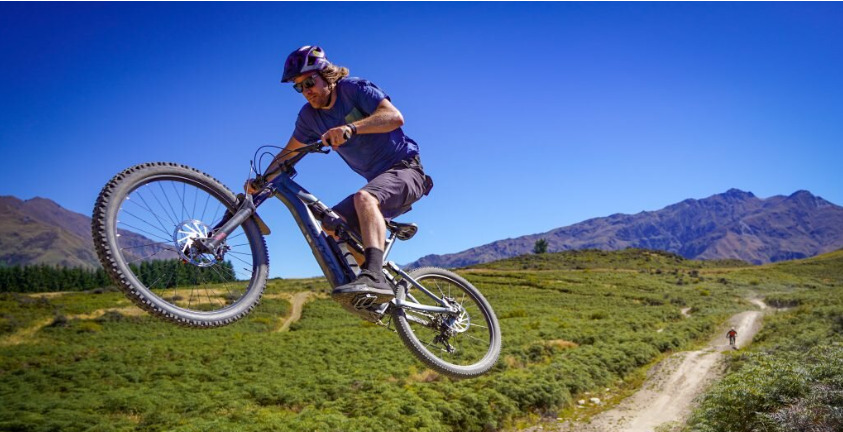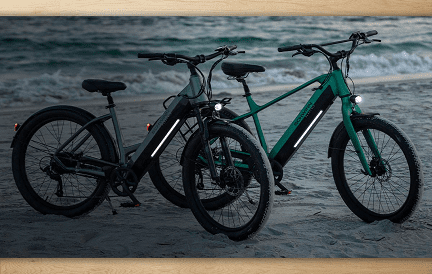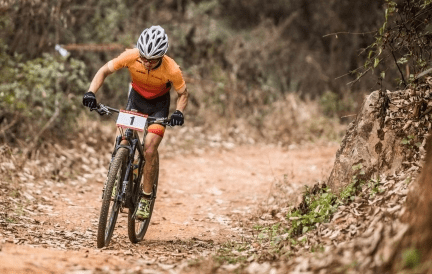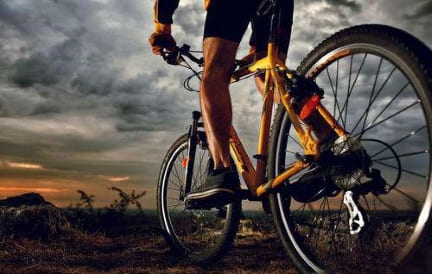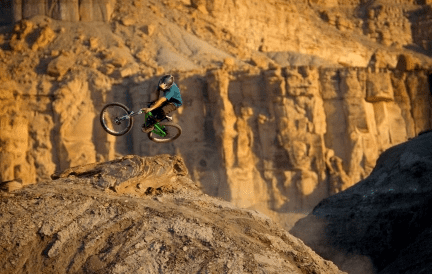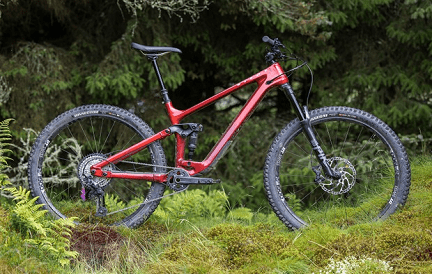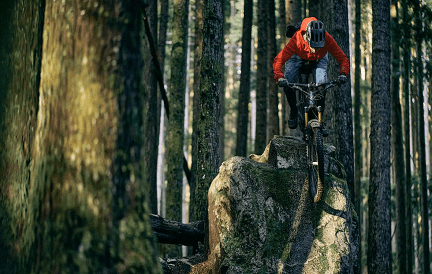27.5 mountain bike, 29 mountain bike… And now 27.5+! While we thought modern standards were established, mountain biking is more than ever experiencing a central turning point by rethinking the dimensions of its essential components: the wheels. While the 3 MTB formats fight the lion’s share, I wanted to know more about them. First and foremost, field experience. Precise feelings and experiences to identify with before making up your own mind.
Part 1: Just Enough History
Since its beginnings, mountain biking – a young sport compared to some of its contemporaries – has never ceased to experience significant developments: transmission, braking, tyres, suspensions… A witness to the questionable beginnings of the practice, Greg Noce told it moreover a little ago, at the start of mountain biking, “we were guinea pigs. Now there are no more, or very few, bad bikes.
Indeed, shortly after 2010, we could have thought that the design offices had scrutinized a good part of the domains. In a way, the bulk of the material developments was behind us… It was without count that the 26-inch wheel diameter, established as a significant reference for ages, is simply called into question.
The problem, if I may say so, is that on a bike, this simple dimension impacts all the behavioural aspects of the frame! And now that the 26 inches are disappearing massively from the catalogues, here we are with several different mountain bike formats, which you have to apprehend and understand to find the right shoe… Or rather, a bike that meets your needs! At least, while waiting for the market to make its choice, inevitably.
Part 2: The Famous 3 MTB Formats
In Enduro, the 27.5 inch has mostly taken the place of the 26 inch. Until then, little different from what we knew previously. Let’s just say that the known benchmarks have been transposed to this new diameter: tire sections, rim widths, disc diameters, transmission ratios, handlebar widths, and crank lengths have not necessarily changed from one to the other.
“Not happy to have touched the diameter. Now we are looking at the section…”
If the difference between 26 and 27.5 mtb has sometimes been long overdue, all those who have tried the big 29 wheels say it is obvious. And from a material point of view, it has seen the beginnings of questioning a few key elements. Some have wondered about disc diameters, transmission ratios, suspension travel and tire sections.
But, not content with having touched on the diameter, some thinkers are taking advantage of the opportunity to explore what the section of the tire can bring. The third format in vogue, the 27.5+, made its appearance. Wide rims (more than 35mm) and large section tires (27×2.8 mini) are now on the program…
Questions of the Moment
3 MTB formats fight for the lion’s share… But for what? What are these formats really worth on the pitch? Are they all as consistent as claimed? What are the fundamental differences between each? What are they better suited to than others?
At the same time, this is everything, and simply, the object of this investigation. By dint of elements of response brought here and there, from various sources of magazines, the web, forums, stores… Two negative feelings settle inexorably: having access to a wealth of information synonymous with consensus and the impression of hearing everything and its opposite about everyone.
So, I decided to let only my own feelings express themselves and to see on the ground, and not elsewhere, what these 3 mountain bike formats have in store. A comparison on equal terms. An experience coming directly from the field, with no other filter than that of my own perception of things, at the heart of the action.
The Test Bikes
A simple idea, a not so obvious implementation..! In particular, because there are many good bikes on the market, making a choice is not always easy, and being logistically viable is even less so!
The opportunity presented itself within the Scott test bike fleet. The brand actually has 3 wheel formats in its 2016 catalogue. Better still, it intends them for the same practice, straddling. Therefore, or rather it is THE, Scott Genius who serves (s) as support for this comparative test.
Three high-end bikes, likely to represent the best in each format, within the Scott range. Three models with substantially identical specifications suggest behavioural differences from the wheel format. Three frames, of course, tried on in the same size to overcome the problem… of size!
But also and above all, three chassis of very similar design, both in terms of the architecture of the frame and the kinematics of the suspension, set in a similar way to the origin of the test, following the recommendations of the brand… similar occurrences, in terms of SAG and rebound: between 25 and 30%, for a rebound in the middle of the range to begin with. So go for 30% back, 25% forward, and the red wheels halfway!
At the Train
The differences are felt from the first pedal strokes on the train, a few hundred rolling meters, to reach the first winding track. On this occasion, I use the Twinloc to totally block the suspensions. I thus reinforce the part of the influence of each format in the feelings and cancel any parasitic oscillation of the breaks.
I have my benchmarks on the 27.5 mountain bike that I usually use. Pedalling frequency and pedal stroke intensity feel natural to me. The wheels hit as you pass through a water drainage channel – roughly the diameter of a 29 wheel for 15cm deep. The manoeuvre is bumped. The bike loses speed. The rear suspension plays on its safety and opens to absorb part of the shock. The supports of my pelvis are packed on the saddle. I have to put in a significant pedal stroke to restart the machine. When the slope intensifies, and I have to put myself as a dancer to increase my power, I perceive the tires at the limit of grip. The slightest imperfection in my management of the pedal stroke is enough to cause the precarious hold to drop irreparably.
The 29’s handlebars feel different under the same conditions. Initially, I pull greater… Rounder and slower. Each pedal stroke became longer and smoother. Felt like riding a road bike. Wheels struck the channel. Similar impact intensity, but different cycling attitude. The back suspension sagged less this time, and the cycle kept pace. The following pedal stroke is unexpectedly effortless. 29 is a great dancer. Even on slick surfaces, grip and torque transmission are maintained. And stalling happens gradually.
On the 27.5+, the Sensations Are Still Different
I am first surprised by the liveliness in pedalling. It is ultimately not fitting with the visual impression of the mass and heaviness of the wheels and tires. In the train, inertia is not insurmountable. To small thrusts, the bike finally reacts a bit like the 29. The first pedal strokes are, on the other hand, the occasion for a precise observation: the fastest may not find their way around. There is indeed a pedalling frequency at which the tires pump!
For my part, it is approximately 90 rpm for my 72kg placed on 1.2 bars. So I have to shoot bigger and slower to keep up the pace and avoid the phenomenon. When crossing the channel, the bike slows down like the classic 27.5, but the perception of the impact differs again. Tires settle and bounce. Taken advantage of, this reaction limits the oscillation of the suspension. It makes it easier to get out of the hole. As a dancer, the 27.5 offers a demonic grip. A tone above the 29, the use of the tire is simply no longer at the limit of grip. Where the other two stumble, the 27.5+ holds and just doesn’t seem to struggle.
On Braking
Once on the hill, I take my marks, sit down, and quietly await the first action. Braking lets me control the mounts before the first obstacle.
On the 27.5 bikes, I clearly perceive that the tires are at the grip limit when I press my braking. As in pedalling, this format seems to push the tires to their limit in a dancer. On the other hand, I can easily adjust the angle and direction the bike takes until the last moment. A quick little jerk is enough to slide the rear wheel to place it against a support. The bumpier the terrain, the more shuffled I get, but the more efficiently the bike seems to lose speed.
Again, the 29’s growing grip is felt. No more jerk placing the bike rapidly. Progressiveness permits controlled deviations. Like the gliding effect of driving on a track: modest dose. At high speed, we also notice the more substantial gyroscopic effect: altering angle or direction is simpler once the bike slows down. The 29 lacks bite and brakes less firmly when the terrain is rough. The wheels fly more than they strike barriers.
On the 27.5+, the bike feels like it’s on a rail. It’s the same feeling as when braking when the fork or the tire of a classic motorcycle is sorely lacking in pressure. There, however much I push the pressure higher – up to 1.7 bars where the other control parameters drop sharply – the effect remains present. No call/counter calls. The trajectory must be as straight and open as possible. It is, therefore, necessary to do what is essential to break in a slightly curved line and not to put on the brakes excessively. A good exercise, by the way, allows you to work on the timing to properly approach the turns…
Curved
In curve precisely, the 27.5 offers a playful temperament, very active. In particular by its propensity to pick up quickly. When it is necessary to correct the shooting, an asset is to type support and turn short. If necessary, moving from one edge to another to chain the pif-pads is done in a quarter of a second. I find it easier to leverage mass transfer back and forth to push the bike and generate speed to get out fast. Clearly, as long as the ground is a minimum raised to lean on, the 27.5 allows you to use everything you can develop on a pump track.
The 29 is More Comfortable on Long Flat Turns
Loading the inner arm to enjoy the grip of the front wheel with confidence is a treat. Whether or not there is a ledge to lean on is irrelevant. I fix the exit, and I pedal early if necessary. I take advantage of the grip. The tack changes highlight the difference between the 29. We feel that going from one to the other is done differently. Not necessarily slower, but the parts of rider and bike influence are different. Once the equilibrium point has passed, the 29 does not seem to “fall” on its own. You have to keep pushing it down so that it takes the angle. A need must be tamed if you want to have a chance to chain the pif-pads at a reasonable speed.
On the 27.5+, tire volume seems to play a multi-tiered role in the edge changes in the first place. The bike really appears to be on the ground. It almost feels like riding these three-wheeled scooters. I’m exaggerating, but I almost have the feeling that if I dropped the bike upright, on the angle, it wouldn’t tip over. Without going that far, the precision required is also different. It is not essential to be very fine and precise to take advantage of the support.
As long as part of the tire bites the edge, the carcass does the rest, and you can reasonably push without fear. This is precisely where the second kiss-cool effect appears: tire rebound plays a significant role in the bike’s response. If the intensity of the speed and the support correspond to that of the rebound of the tire, what the cycle returns is a treat, and the flow of the path is increased tenfold.
At the Revival
When relaunching, the 3 mountain bike formats reach the climax of their differences… And above all, some limits are no longer offset by another attractive character trait.
In this area, the 27.5 inch cycleis undeniably the most comfortable. As soon as the action is over, sometimes even at heart – on short bends in particular – the first pedal stroke can occur early, and the relaunch can be very swift. The speed increases from the first pedal stroke, and placing three pedal strokes to recover his favourite support foot is a treat. Under these conditions, it is not uncommon for the front wheel to lose weight and the bike to rear up slightly if you pull on the handlebars. A unique attitude to make the show full of sensations.
The 29 of This Test Is Doing Well
Thanks to the carbon rims, which favour the low inertia of the wheels. At very high intensity, I feel that it saturates, all the same, a little. I try to press even harder. There is a threshold beyond which the power no longer passes. Although I drop the reports, the feeling of pulling a little bigger is persistent. At equivalent efficiency, where I have room for 3 pedal strokes in 27.5, I only place 2 in 29.
The 27.5+ does well, but this is also a limit of this format. I think especially for the competitors. The threshold effect is present, a tone earlier still than with the 29. Impossible to raise very strongly and take advantage of it. It is necessary to round off the pedal strokes and put all the techniques of braking and passage in curve or crossing, which precedes the relaunch to facilitate the latter and be in a register that is going well.
In the Air
It’s time to get the wheels off the ground. In the air, place three parallel worlds. The 27.5 allows you to take advantage of the most succinct calls to fly away. And all it takes is a push of the kidney or the handlebars for the style to be there. Whiper, scrubber, I have no trouble using the usual panoply of the rider who wants to put type in his riding.
For the 29, the usable calls’ dimensions – slope and height – differ. The hill must, in particular, be softer and rounder to take advantage of it. Before that, it is better to roll up. The 29 does well: breaking down a bunny-up is easy. I have known more capricious in the past. The geometries evolve favourably on this subject. As with the call, the Whip and the Scrub are done differently. Those who want to take themselves for James Stewart will go their ways. Manoeuvres are possible but must be rounder, less impulsive and incisive.
The 27.5+ once again brings a different but equally coherent vision. As in curves, the flow and the timing must correspond with the demand of the ground. Otherwise, the rebound and problems of attitude are clearly felt. But what can hinder those who switch from one format to another can be an advantage for those who are just starting out or taking the time to adapt. The rebound, in particular, and the sagging of the tires on takeoff and landing help and compensate for certain shortcomings, in a touchdown, in particular…
Felt from the Field
By that, I mean all the little information that we perceive from the terrain through the bikes’ vibrations, shocks, and movements transmitted to us. Some speak of touch, others of feeling. In any case, it is about what reaches us once the bicycle filter has been crossed. In this case, it is clearly not the same…
Like all of these 3 Scotts, the mtb 27.5 looks pretty light. It is perhaps the one that seems the most fickle to the touch. The slightest roughness of the ground makes it vibrate. Pebbles, holes, variations in the hardness of the ground… the least of this information reach us. Compared to the other two, they almost seem unfiltered, even if we know that this is not the case…
The 29 Filters the First Part of the Information
As if there were a range of dimensions of asperities that it transmits differently. On a long rocky slab with a surface eroded by time, for example. The 29 smoothes the ground. If I believe my GPS, you really have to reduce the speed to 8/9 km/h to feel the vibrations more. As if there was a speed below which you should not go to take full advantage of the format’s benefits.
The 27.5+ stands out very clearly from the other two in this area. If only the sound that the ground emits in contact with the tires. On the Gravette, in particular, the much larger contact surface with the base causes more particles to move, which “squeal” more than the other two. Then on the rocks. It’s effortless: I feel like riding in another universe than the South-East quarter of France. A world where the landscapes are the same but all the pebbles less than 10cm in diameter have disappeared. Gone is the one who sways the front wheel, shifts the rear wheel, hits the wrists, pats the ass or goes up the spokes. The tires literally swallow them up, totally eliminating their presence.
When It Gets Complicated
In the long run, this feeling of the terrain necessarily does its work. Especially in Enduro, where fatigue and wear constantly influence the quality and precision of the piloting deployed. In these circumstances, the 3 MTB formats offer very distinct attributes on which to count when the time comes…
The 27.5 has the responsiveness and precision it can demonstrate. Understand by this that in a critical situation, it makes it possible to react in record time to correct the problem. The tenth of a second and the few centimetres sometimes allow you to get out of a delicate and badly started situation. The ideal nervousness to quickly restart the machine after a stoppage or an error… A reaction for which it is necessary to show a minimum of dynamism, even the legs and arms burnt by several long minutes of exhausting negative elevation.
The 29 Can Promote And Maintain Speed
On rough terrain, it allows you to pedal where others require, above all finesse and relief to not hit and stop. And once launched, it will enable you to agree to micro relaxation time to recover your health and better hold the following supports. An ability that is all the more felt as the run continues tirelessly. And in the long run, a tendency to postpone the moment when, with death in the soul and morale in the socks, we end up abdicating and lowering our voices to reach the end without further ado.
I was afraid that the 27.5+ would wear out in the long run. However, there is nothing. Obviously, it is necessary to avoid trying to raise constantly, as with a classic 27.5. Otherwise, the juice quickly runs out! The format reveals its potential by seeking more to smooth and fluidify the effort. That of an inveterate eye-catching roller. No more small slips due to poorly controlled timing due to fatigue. From start to finish, the feel and grip are easy and controlled. Attention spent on touching the ground becomes attention on pushing and bouncing in phase with the tires. To round off and smoothen the trajectories and the passages to keep the speed. In this little game, the thighs, the flexion of the knees, the calves, and the ankles’ flexibility play on more amplitude and in a different harmony… Perhaps less pleasing and nervously demanding…
Trim and Position
In the long run, too, we perceive another difference… The Scott size guide is formal. On the one hand, the M sizes available to me are at the limit for my size of one meter eighty-two. On the other hand, the three models tested follow the same recommendations for this overall size. However, on the ground, the sensations differ.
It’s the differences in trim behaviour that make me feel. If on the train, I think posed in a similar way, it is enough that the bike’s attitude varies, in a sequence of steps, for example, to give me different sensations.
On the cycle 27.5 inch, I feel the bike’s size is on the edge of what I would typically use. I rode between two sizes for a very long time, at a time when most brands only offered 3 sizes. On this M, I find similar sensations with the feeling of having to lower my line of shoulders as close as possible to the hanger to avoid making the mast of the boat. And be sure to have, whatever happens, the line of shoulders slightly set back from the handlebars to avoid being taken on board beyond the handlebars in the event of a sudden stop.
The 29 Seems More Significant to Me
Quite simply, my size. In fact, I feel more seated “in the heart” of the bike, between the two wheels, rather than above. Is it the fact that my centre of gravity is more “behind” the front wheel’s axle or the fact that the 29 does not stumble less in obstacles, making me feel little stopping? Both may be, giving me extra confidence when getting through the most rutted areas.
On the 27.5+, the impression is similar to that of the 29, with the difference that the rebounds and deformations of the tires suggest a zone of “fuzziness” in the bike’s attitude. As much as I can play with the suspension settings of the previous two to fine-tune the balance and trim of the bikes, the tires on the 27.5+ bring an unusual complication. Their deformations, their subsidence, and their rebounds necessarily come into play. When the assembly is not balanced, the bike tends to bounce back and forth and vice versa, straining the arms, legs and sheathing intensively. While I’m used to dealing with SAG, rebound, and, if necessary, low-speed compression, here, too, you have to take into account the pressures and casings of the front and rear tires. No small feat…
Part 3: What to Think
Precisely, these last feelings bring me to a particular conclusion. Far be it from me to conclude hastily by suggesting easy reductive shortcuts. I would not detail all of my feelings for so little.
In my view, there is no ideal format. For the time being, the 3 MTB formats stand together and bring their share of advantages… Or disadvantages. One might be tempted to opt for one and work on its development to erase some of its faults. You have to be careful. As we don’t make a racehorse out of a donkey, we will never make a current bicycle 27.5 inch a 27.5+ or 29, and vice versa.
We can undoubtedly refine specific points to approach another but beware of sacrifices. I am particularly thinking of the liveliness of the 27.5+ when relaunching, with lighter tires but too fragile… The use of soft rubbers, which wear out very quickly to gain a grip on the 27.5 inch mountain bike… At this small game, the 29 in this test were already using carbon rims to gain liveliness when relaunching, without ever having matched the 27.
Everyone Is Free to Put Down Their Crosses And Do Their Accounts Knowingly
So, there are almost as many answers as there are people in this little game. Rather than generalise, we are now with precise and detailed elements, which should allow everyone to get an idea. The idea is to allow everyone to identify, or not, with each situation mentioned. Take the time to think about your preferences: do you prefer to turn in a pocket-handkerchief or not have to demonstrate surgical precision in curves, for example. Or to wonder about how we manage our efforts over long runs and what primary quality can increase our strengths when the time comes? The most Cartesian among us will do it in the form of a table: each situation has its line, and each wheel format has its column. Everyone is free to place their crosses where they want.


